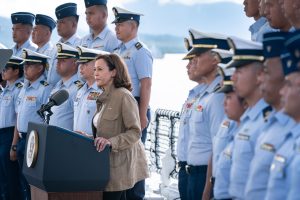Expectations have once again risen with respect to the U.S.-Philippine alliance, with the new EDCA sites announcement following U.S. Defense Secretary Lloyd Austin’s trip to the Philippines being just the latest case in point. These expectations are understandable, particularly on the security side, given contingencies such as terrorism, disaster management, tensions over Taiwan, and manifestations of China’s ongoing maritime assertiveness in the South China Sea. Yet they also point to an ongoing need to further widen the aperture of collaboration under President Ferdinand Marcos Jr., both to maximize opportunities and address common challenges.
Traditional conceptions of the U.S.-Philippine alliance may have been dominated by security concerns, but as I have detailed previously, there have long been tensions about how to balance security and non-security considerations, including regarding some of the U.S.’ other regional alliances and partnerships in Southeast Asia. During protracted allied base negotiations in the 1970s under the presidency of Marcos’ father, Ferdinand E. Marcos, the issue was framed in terms of the economic benefits for the regime and the Philippine economy, rather than just its role in wider strategic considerations. And as early as the 2000s, during the administration of President Gloria Macapagal-Arroyo, there was already a trend in which, in spite of a continued focus on U.S.-Philippine security ties in a post-9/11 context, challenges persisted on the economic side and Manila’s increasing reliance on a rising China for economic engagement was also producing its share of concerns, with a case in point being the controversial joint development deal in the South China Sea that quickly unraveled by 2008, as it became embroiled in one of the largest corruption scandals in Philippine history.
The case for further widening the scope of collaboration within the U.S.-Philippine alliance is even clearer to both sides today, and we are seeing evidence of this affecting the contours of the relationship. Marcos’ foreign trips since taking office last year have highlighted economic sectoral areas such as infrastructure, digital technology, and health, in line with some initial scrutiny about the benefits of these visits. Meanwhile, the administration of President Joe Biden, in line with demand signals coming from parts of the region, has rightly recalibrated its messaging on U.S.-China competition to balance this with advancing cooperation with countries, as noted in the administration’s National Security Strategy, in order to meet their own needs. Even traditional U.S. treaty allies in Asia like Thailand and the Philippines have already begun to see a relatively greater focus on non-security components as countries look to recover from COVID-19 amid a still uncertain economic climate.
Yet there is more that both sides can do to deepen collaboration in certain realms. On the economic side, one specific area of cooperation that could be built out is in agriculture and food security, given Marcos’ own emphasis on this (he still holds the agriculture portfolio) and the spotlight on this sector early on in his administration regarding the management of sugar imports and onion prices. The new food security dialogue publicly announced during Vice President Kamala Harris’ trip to the Philippines in November presents an opportunity to advance cooperation in this domain.
In the people-to-people domain, Washington and Manila could work through ways to more directly feature engagements with stakeholders such as Philippine fishermen in some of their existing maritime and environment-related activities in areas like marine protection and ocean plastic pollution, which are already expanding, given their role on security-related issues like the South China Sea. This would have the added effect of messaging strategic issues in ways that more directly impact people, as Marcos himself did when he talked about a potential Japan-Philippines defense agreement as a means of “protecting our fishermen.”
Broadening areas of potential cooperation could also help both sides address challenges in the relationship. One area in this respect is strategic infrastructure investment, where China has already been active in trying to involve itself economically in projects that have security implications on the Fuga, Chiquita, and Grande islands, the Sangley International Airport, and the Hanjin shipyard. Beyond the case of the U.S. acquisition of the Hanjin shipyard, which Philippine officials themselves highlighted as a success, Washington and Manila need to find individual and collective pathways to manage these instances more sustainably in the longer run, and also deepen the localization of the alliance such that it is felt by politicians within the country.
Another is an emphasis on historical and cultural aspects of the alliance, to both remind newer generations of Filipinos about its foundation and also to more candidly address its full legacy, including areas of potential sensitivity, so that the alliance can better weather periods like the one we saw under Rodrigo Duterte, who was initially vocal about his anti-American views. Some of this is already ongoing, such as U.S. Ambassador to the Philippines MaryKay Carlson’s visit to the Balangiga Bells, which were returned in 2018.
To be sure, widening the aperture of alliance collaboration will not be an easy task. Broadening will naturally require partnerships with a wider range of stakeholders, be it private companies or communities of people, some of whom may initially be ambivalent about, or concerned by, some areas of collaboration. Practically speaking for alliance managers, breadth must be managed alongside depth and length to maximize the volume of cooperation that advances the interests of both sides. And even as the alliance’s scope expands, some of the issues occurring within the Philippines will still be subject to Manila’s own actions and initiatives that it pursues with other partners as well.
Yet the evolving needs of both Manila and Washington, as well as a more competitive strategic environment, support the case for this broader perspective. As we see increased alliance collaboration take shape in 2023 and beyond amid a sea of engagements, that will be important to keep in mind.

































